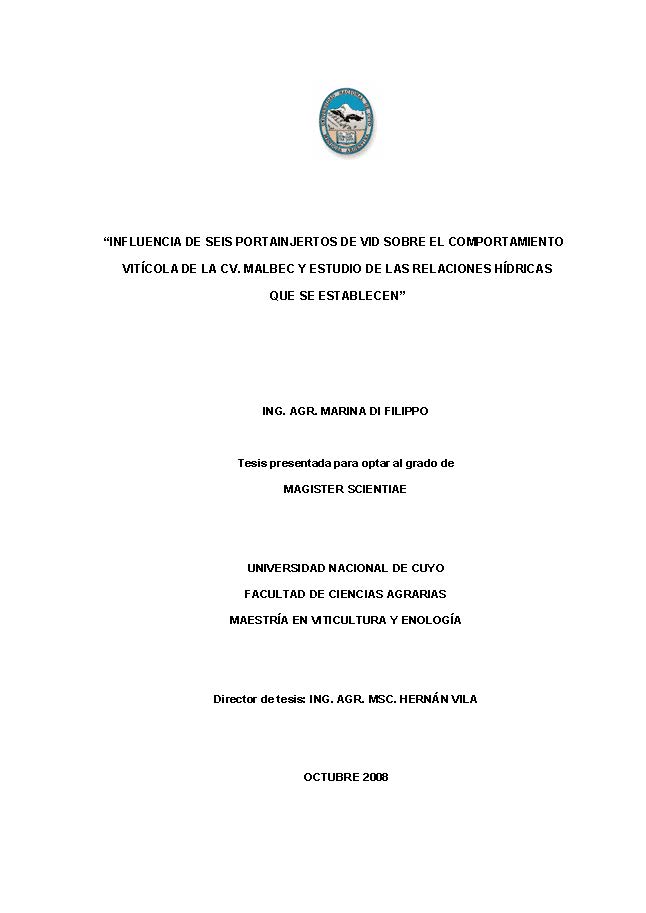Ver ítem
- xmlui.general.dspace_homeCentros Regionales y EEAsCentro Regional Mendoza - San JuanEEA MendozaTesisxmlui.ArtifactBrowser.ItemViewer.trail
Influencia de seis portainjertos de vid sobre el comportamiento vitícola de la cv. Malbec y estudio de las relaciones hídricas que se establecen
Resumen
El uso de portainjertos en la vid se ha difundido por su resistencia a filoxera y nemátodos, pero también por su tolerancia a condiciones adversas del suelo. Por otro lado, los portainjertos modifican las relaciones fuente-destino, influyendo en el comportamiento vegetativo y reproductivo de las plantas y en la composición de la uva, lo cuál puede ser utilizado como una herramienta de manejo agronómico. A fin de evaluar si existe un comportamiento
[ver mas...]
El uso de portainjertos en la vid se ha difundido por su resistencia a filoxera y nemátodos, pero también por su tolerancia a condiciones adversas del suelo. Por otro lado, los portainjertos modifican las relaciones fuente-destino, influyendo en el comportamiento vegetativo y reproductivo de las plantas y en la composición de la uva, lo cuál puede ser utilizado como una herramienta de manejo agronómico. A fin de evaluar si existe un comportamiento diferencial de los portainjertos en cuanto a expresión vegetativa, vigor, rendimiento y composición de la uva, y explicar dichas diferencias en términos de exploración radical, relaciones hídricas, asimilación de carbono, eficiencia en el uso del agua y partición de asimilados se realizó un ensa-yo a campo de cv. Malbec sobre seis portainjertos (3309 C, 1103 P, 140 Ru, SO4, Harmony y Cereza) y a pie franco. Los portainjertos 140 Ru, 1103 P y SO4 tuvieron una mayor tendencia a la producción de uva (mayor Índice de Ravaz), y Franco, Cereza y 3309 C a vegetar, mostrando Harmony una situación intermedia. Las ba-yas sobre el pie Cereza tuvieron un mayor peso (1,96 g) que sobre Harmony (1,75 g). No se encontraron diferencias en los polifenoles de las bayas entre portainjertos. La fotosíntesis de la planta entera (Amax) de Franco, 1103 P y SO4 fue mayor que la de Harmony. La conductancia hidráulica foliar específica (kL) de Harmony fue me-nor que la de Cereza, y su conductancia hidráulica (kH) fue menor que la de Franco, Cereza y SO4. El número de raíces totales de 140 Ru fue mayor que el de 1103 P, SO4 y Harmony. El portainjerto 140 Ru se destacó por privilegiar el desarrollo radi-cal y reproductivo sobre el vegetativo, y por su mayor eficiencia en el uso del agua (EUA). Las diferencias entre portainjertos pueden ser explicadas en parte por dife-rencias en la kL que a su vez incide en el estado hídrico de las plantas (ΨL). De ma-nera que cuando la kL es más baja, el ΨL es menor (i.e., Harmony), y cuando la kL es más alta, el ΨL es mayor (i.e., Franco y Cereza). Mayores ΨL se asocian con mayores superficies foliares.
[Cerrar]
The use of rootstocks in grapevine has been diffused not only for its resis-tance against phylloxera and nematodes, but also for its tolerance to overcome site difficulties. On the other hand, rootstocks modify the relation between source and sink, having influence on the vegetative and reproductive behaviour of the plants and the grapes quality. Therefore they can be used as an agronomic tool. A trial was performed on field growth plants of cv. Malbec on
[ver mas...]
The use of rootstocks in grapevine has been diffused not only for its resis-tance against phylloxera and nematodes, but also for its tolerance to overcome site difficulties. On the other hand, rootstocks modify the relation between source and sink, having influence on the vegetative and reproductive behaviour of the plants and the grapes quality. Therefore they can be used as an agronomic tool. A trial was performed on field growth plants of cv. Malbec on six rootstocks (3309 C, 1103 P, 140 Ru, S04, Harmony and Cereza) and on own roots (Franco) in order to evaluate if there is a differential behaviour of the rootstocks with regard to vegetative expres-sion, vigour, yield and grape quality and to explain such differences in terms of roots exploration, water relations, CO2 assimilation, water use efficiency and carbohy-drates partitions. The rootstocks 140 Ru, 1103 P and SO4 had a higher tendency to the grape production (higher index of Ravaz), meanwhile Franco, Cereza and 3309 C seemed to vegetate more, and Harmony showed a middle condition. The berries of Cereza had a higher weight (1.96 g) than the one of Harmony (1.75 g). No differ-ences in the poliphenolics of the berries among the rootstocks have been found. The whole plant photosynthesis (Amax) of Franco, 1103 P and SO4 was higher than the Amax of Harmony. Leaf specific hydraulic conductance (kL) of Harmony was lower than the kL of Cereza and its hydraulic conductance (kH) was lower than the kH of Franco, Cereza and SO4. Total roots number of 140 Ru was higher than those of 1103 P, SO4 and Harmony. The rootstock 140 Ru showed off for its favorable car-bohydrates partitions and its higher water use efficiency (EUA). The differences be-tween rootstocks could be explained partly to differences in the kL that affected the water status of the plants (ΨL). So that when the kL is lower, the ΨL is lower (e.g., Harmony) and when the kL is higher, the ΨL is greater (e.g., Franco and Cereza). Higher ΨL are associated with greater leaf areas.
[Cerrar]

Director de Tesis
Descripción
Tesis para obtener el grado de Magister Scientiae en Viticultura y Enología, de la Universidad Nacional de Cuyo, en 2008
Fecha
2008
Editorial
Facultad de Ciencias Agrarias, Universidad Nacional de Cuyo
Formato
pdf
Tipo de documento
tesis de maestría
Palabras Claves
Derechos de acceso
Abierto
 Excepto donde se diga explicitamente, este item se publica bajo la siguiente descripción: Creative Commons Attribution-NonCommercial-ShareAlike 2.5 Unported (CC BY-NC-SA 2.5)
Excepto donde se diga explicitamente, este item se publica bajo la siguiente descripción: Creative Commons Attribution-NonCommercial-ShareAlike 2.5 Unported (CC BY-NC-SA 2.5)


